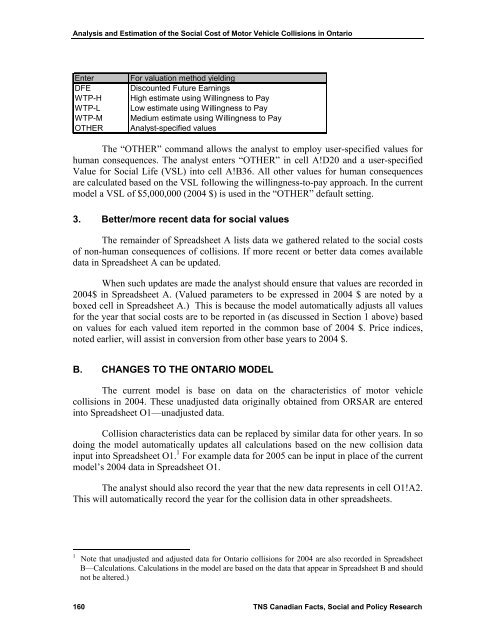Keith Vodden Dr. Douglas Smith - Transports Canada
Keith Vodden Dr. Douglas Smith - Transports Canada
Keith Vodden Dr. Douglas Smith - Transports Canada
You also want an ePaper? Increase the reach of your titles
YUMPU automatically turns print PDFs into web optimized ePapers that Google loves.
Analysis and Estimation of the Social Cost of Motor Vehicle Collisions in Ontario<br />
Enter<br />
DFE<br />
WTP-H<br />
WTP-L<br />
WTP-M<br />
OTHER<br />
For valuation method yielding<br />
Discounted Future Earnings<br />
High estimate using Willingness to Pay<br />
Low estimate using Willingness to Pay<br />
Medium estimate using Willingness to Pay<br />
Analyst-specified values<br />
The “OTHER” command allows the analyst to employ user-specified values for<br />
human consequences. The analyst enters “OTHER” in cell A!D20 and a user-specified<br />
Value for Social Life (VSL) into cell A!B36. All other values for human consequences<br />
are calculated based on the VSL following the willingness-to-pay approach. In the current<br />
model a VSL of $5,000,000 (2004 $) is used in the “OTHER” default setting.<br />
3. Better/more recent data for social values<br />
The remainder of Spreadsheet A lists data we gathered related to the social costs<br />
of non-human consequences of collisions. If more recent or better data comes available<br />
data in Spreadsheet A can be updated.<br />
When such updates are made the analyst should ensure that values are recorded in<br />
2004$ in Spreadsheet A. (Valued parameters to be expressed in 2004 $ are noted by a<br />
boxed cell in Spreadsheet A.) This is because the model automatically adjusts all values<br />
for the year that social costs are to be reported in (as discussed in Section 1 above) based<br />
on values for each valued item reported in the common base of 2004 $. Price indices,<br />
noted earlier, will assist in conversion from other base years to 2004 $.<br />
B. CHANGES TO THE ONTARIO MODEL<br />
The current model is base on data on the characteristics of motor vehicle<br />
collisions in 2004. These unadjusted data originally obtained from ORSAR are entered<br />
into Spreadsheet O1—unadjusted data.<br />
Collision characteristics data can be replaced by similar data for other years. In so<br />
doing the model automatically updates all calculations based on the new collision data<br />
input into Spreadsheet O1. 1 For example data for 2005 can be input in place of the current<br />
model’s 2004 data in Spreadsheet O1.<br />
The analyst should also record the year that the new data represents in cell O1!A2.<br />
This will automatically record the year for the collision data in other spreadsheets.<br />
1<br />
Note that unadjusted and adjusted data for Ontario collisions for 2004 are also recorded in Spreadsheet<br />
B—Calculations. Calculations in the model are based on the data that appear in Spreadsheet B and should<br />
not be altered.)<br />
160 TNS Canadian Facts, Social and Policy Research
















